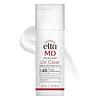What's inside
What's inside
 Key Ingredients
Key Ingredients

 Benefits
Benefits

 Concerns
Concerns

No concerns
 Ingredients Side-by-side
Ingredients Side-by-side

Camellia Sinensis Leaf Water
MaskingCaprylic/Capric Triglyceride
MaskingCoco-Caprylate
EmollientGlycerin
HumectantPolyglyceryl-6 Stearate
EmollientCapryloyl Glycerin/Sebacic Acid Copolymer
Skin ConditioningWater
Skin ConditioningOryza Sativa Bran Extract
Skin ConditioningSqualane
EmollientPolyhydroxystearic Acid
EmulsifyingHippophae Rhamnoides Seed Oil
Skin ProtectingSilybum Marianum Ethyl Ester
Skin ConditioningPisum Sativum Peptide
Skin ConditioningTerminalia Chebula Fruit Extract
Skin ConditioningHaematococcus Pluvialis Powder
AntioxidantSimmondsia Chinensis Seed Oil
EmollientAloe Barbadensis Leaf Juice
Skin ConditioningCamellia Sinensis Leaf Extract
AntimicrobialCitrus Aurantium Amara Flower Cera
Skin ProtectingIsopropyl Jojobate
EmollientJojoba Alcohol
EmollientJojoba Esters
EmollientXanthan Gum
EmulsifyingPolyglyceryl-6 Behenate
Emulsion StabilisingLactic Acid
BufferingAcacia Senegal Gum
MaskingDipotassium Glycyrrhizate
HumectantAllantoin
Skin ConditioningPhenethyl Alcohol
MaskingEthylhexylglycerin
Skin ConditioningSodium Phytate
Leuconostoc/Radish Root Ferment Filtrate
AntimicrobialTocopherol
AntioxidantCamellia Sinensis Leaf Water, Caprylic/Capric Triglyceride, Coco-Caprylate, Glycerin, Polyglyceryl-6 Stearate, Capryloyl Glycerin/Sebacic Acid Copolymer, Water, Oryza Sativa Bran Extract, Squalane, Polyhydroxystearic Acid, Hippophae Rhamnoides Seed Oil, Silybum Marianum Ethyl Ester, Pisum Sativum Peptide, Terminalia Chebula Fruit Extract, Haematococcus Pluvialis Powder, Simmondsia Chinensis Seed Oil, Aloe Barbadensis Leaf Juice, Camellia Sinensis Leaf Extract, Citrus Aurantium Amara Flower Cera, Isopropyl Jojobate, Jojoba Alcohol, Jojoba Esters, Xanthan Gum, Polyglyceryl-6 Behenate, Lactic Acid, Acacia Senegal Gum, Dipotassium Glycyrrhizate, Allantoin, Phenethyl Alcohol, Ethylhexylglycerin, Sodium Phytate, Leuconostoc/Radish Root Ferment Filtrate, Tocopherol
Zinc Oxide 9%
Cosmetic ColorantEthylhexyl Methoxycinnamate 7.5%
UV AbsorberWater
Skin ConditioningCyclopentasiloxane
EmollientNiacinamide
SmoothingOctyldodecyl Neopentanoate
EmollientHydroxyethyl Acrylate/Sodium Acryloyldimethyl Taurate Copolymer
Emulsion StabilisingButylene Glycol
HumectantPhenoxyethanol
PreservativePolyisobutene
Triethoxycaprylylsilane
Tocopheryl Acetate
AntioxidantPEG-7 Trimethylolpropane Coconut Ether
EmulsifyingOleth-3 Phosphate
Iodopropynyl Butylcarbamate
PreservativeLactic Acid
BufferingSodium Hyaluronate
HumectantPhosphoric Acid
BufferingZinc Oxide 9%, Ethylhexyl Methoxycinnamate 7.5%, Water, Cyclopentasiloxane, Niacinamide, Octyldodecyl Neopentanoate, Hydroxyethyl Acrylate/Sodium Acryloyldimethyl Taurate Copolymer, Butylene Glycol, Phenoxyethanol, Polyisobutene, Triethoxycaprylylsilane, Tocopheryl Acetate, PEG-7 Trimethylolpropane Coconut Ether, Oleth-3 Phosphate, Iodopropynyl Butylcarbamate, Lactic Acid, Sodium Hyaluronate, Phosphoric Acid
 Reviews
Reviews

Ingredients Explained
These ingredients are found in both products.
Ingredients higher up in an ingredient list are typically present in a larger amount.
Lactic Acid is another well-loved alpha hydroxy acid (AHA). It is gentler than glycolic acid but still highly effective.
Its main role is to exfoliate the surface of the skin by loosening the “glue” that holds dead skin cells together. Shedding those old cells leads to smoother, softer, and more even-toned skin.
Because lactic acid molecules are larger than glycolic acid, they don’t penetrate as deeply. This means they’re less likely to sting or irritate, making it a great choice for beginners or those with sensitive skin.
Like glycolic acid, it can:
Lactic acid also acts as a humectant (like hyaluronic acid). It can draw water into the skin to improve hydration and also plays a role in the skin's natural moisturizing factor (NMF) in the form of sodium lactate.
Studies show it can boost ceramide production to strengthen the skin barrier and even help balance the skin’s microbiome.
To get results, choose products with a pH between 3-4.
Lower strengths (5-12%) focus on surface exfoliation; higher strengths (12% and up) can reach deeper in the dermis (deeper, supportive layer) to improve skin texture and firmness over time.
Though it was originally derived from milk, most modern lactic acid used in skincare is vegan. It is made through non-dairy fermentation to create a bio-identical and stable form suitable for all formulations.
When lactic acid shows up near the end of an ingredient list, it usually means the brand added just a tiny amount to adjust the product’s pH.
Legend has it that Cleopatra used to bathe in sour milk to help reduce wrinkles.
Lactic acid is truly a gentle multitasker: it exfoliates, hydrates, strengthens, and brightens. It's a great ingredient for giving your skin a smooth, glowing, and healthy look without the harshness of stronger acids.
Read more about some other popular AHA's here:
Learn more about Lactic AcidWater. It's the most common cosmetic ingredient of all. You'll usually see it at the top of ingredient lists, meaning that it makes up the largest part of the product.
So why is it so popular? Water most often acts as a solvent - this means that it helps dissolve other ingredients into the formulation.
You'll also recognize water as that liquid we all need to stay alive. If you see this, drink a glass of water. Stay hydrated!
Learn more about Water